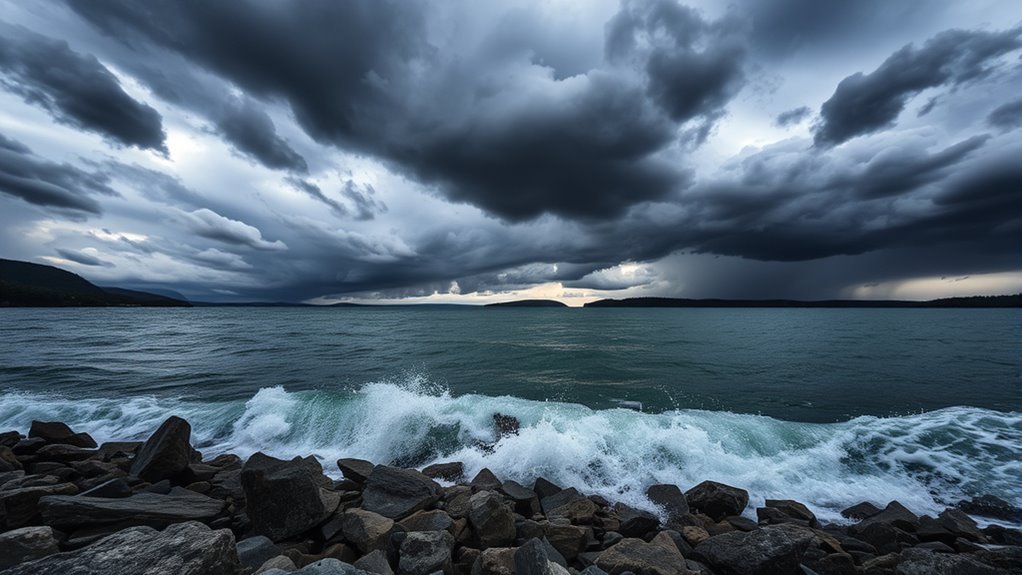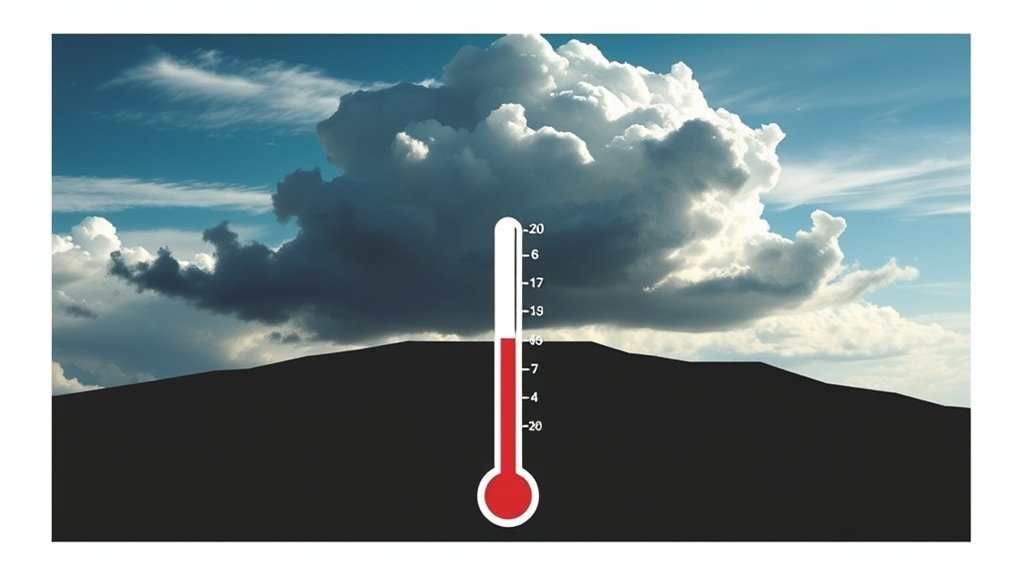Common mistakes in predicting and understanding squalls include overlooking local weather patterns and ignoring changes in wind direction. Many misinterpret radar images, focusing solely on precipitation intensity. Others underestimate the speed of approaching squalls or fail to monitor temperature drops. Some assume squalls occur only in specific seasons, disregarding their year-round potential. Finally, neglecting the impact of terrain on squall development can lead to inaccurate forecasts. Further understandings into these pitfalls can prove essential for better preparedness.
Main Points
- Relying solely on broad weather forecasts can lead to underestimating localized squall conditions and their intensity.
- Misinterpreting radar images often results in overlooking critical wind speed data essential for understanding squall dynamics.
- Ignoring local topography and its influence on microclimates can lead to inaccurate squall predictions.
- Assuming squalls only occur in specific seasons neglects their potential year-round formation due to varying atmospheric conditions.
- Failing to monitor atmospheric changes, like temperature drops and wind shifts, can leave individuals unprepared for sudden squall developments.
Overlooking Local Weather Patterns
Although many people may focus on broad weather forecasts, overlooking local weather patterns can lead to misunderstandings about squalls. These localized phenomena often develop rapidly and can vary considerably from one area to another.
For instance, a region may be experiencing clear skies while a nearby area faces intense squall conditions. This discrepancy is critical for individuals engaging in outdoor activities or maritime operations, as they may underestimate the risk posed by sudden weather changes.
Local topography, such as hills and valleys, can also influence squall formation, creating microclimates that differ from general forecasts. Additionally, factors like humidity and temperature fluctuations play an essential role in local weather dynamics.
As a result, relying solely on generalized forecasts without considering nearby weather indicators may result in dangerous situations. A thorough understanding of local patterns is imperative for accurate squall prediction and effective preparedness.
Ignoring Changes in Wind Direction

Ignoring changes in wind direction can lead to considerable misunderstandings about the approach of squalls.
Wind shifts are often precursors to these weather events, highlighting the importance of analyzing patterns and trends.
Utilizing appropriate tools for wind monitoring can greatly improve awareness and preparedness.
Wind Shifts Indicate Squalls
When evaluating the onset of squalls, many individuals focus solely on wind shifts, often overlooking substantial changes in wind direction. This fixation can lead to misinterpretations, as it is essential to acknowledge that squalls may not always manifest through conventional wind shifts alone.
Variations in wind direction can provide critical clues about the approaching instability. For instance, a sudden veer or backing of the wind can indicate shifts in atmospheric pressure and temperature, which are common precursors to squalls.
Ignoring these directional changes can result in inadequate preparedness for the imminent weather conditions. Awareness of both wind shifts and directional changes improves understanding and prediction of squalls, ultimately promoting better safety measures for those affected by such weather phenomena.
Analyzing Patterns and Trends
Patterns and trends in weather observation are essential for predicting squalls, yet many overlook the significance of changes in wind direction. Wind direction shifts can serve as critical indicators of impending squall activity. For instance, a sudden veer in wind can signify the approach of a weather front, which may escalate into a squall. Ignoring these directional changes may lead to misjudgments about the storm's intensity and trajectory.
Additionally, analyzing historical wind patterns can provide meaningful understandings into typical squall behavior in specific regions. By closely monitoring wind direction alongside other meteorological factors, forecasters can improve their predictive accuracy and mitigate risks associated with squalls. Awareness of these trends is essential for effective weather forecasting and public safety.
Tools for Wind Monitoring
Effective wind monitoring tools are essential for understanding weather dynamics, yet many users often overlook the importance of changes in wind direction.
This oversight can lead to misinterpretations and missed warnings about squalls. Various tools exist that can improve understanding, yet their effectiveness diminishes without attention to directional shifts.
- Anemometers for measuring wind speed
- Wind vanes for tracking direction
- Weather stations for thorough data collection
Misinterpreting Radar Images

Frequently, individuals misinterpret radar images, leading to confusion about the nature and intensity of squalls. Radar technology displays precipitation and wind patterns, but it can be challenging to interpret these images accurately. Many users may focus solely on precipitation intensity, overlooking wind speeds and other critical factors that contribute to squall formation. This oversight can result in underestimating the potential severity of a squall.
Furthermore, radar images may show a broad area of rain, leading individuals to assume that squalls will be widespread and uniform. Nevertheless, squalls can be localized, with intense winds and heavy rainfall occurring in specific pockets. Misreading these patterns can create a false sense of security, prompting inadequate preparation for rapidly changing weather conditions.
Ultimately, a thorough understanding of radar interpretation is essential for accurately evaluating squalls and ensuring appropriate responses to these volatile weather events.
Underestimating the Speed of Oncoming Squalls

Underestimating the speed of oncoming squalls can lead to critical misjudgments in timing, often resulting in inadequate preparation.
Many individuals rely on outdated weather monitoring techniques, which may not accurately reflect real-time conditions.
Understanding the dynamics of squalls is essential for enhancing safety and response efforts.
Common Misjudgments in Timing
How often do individuals misjudge the timing of oncoming squalls? This misjudgment can lead to dangerous situations, particularly for those in maritime or outdoor settings. Individuals often assume they have more time than they actually do, resulting in unpreparedness.
- Ignoring signs: Subtle shifts in wind direction or temperature might be overlooked.
- Inaccurate forecasting: Relying solely on outdated or generalized weather reports can distort expectations.
- Overconfidence: Experience can breed complacency, leading to a false sense of security about timing.
These factors contribute to the detrimental consequences of underestimating squalls, emphasizing the importance of vigilance and caution.
Recognizing the potential for rapid changes is essential for effective preparation.
Real-Time Weather Monitoring Techniques
Accurate and timely weather information is essential for those traversing outdoor environments, particularly in the face of rapidly approaching squalls. Real-time weather monitoring techniques play a critical role in enhancing situational awareness.
Utilizing advanced radar systems allows meteorologists to track squall lines and predict their movement with greater precision. Satellite imagery provides a broader view of weather patterns, while weather stations equipped with anemometers and barometers offer localized data on wind speed and atmospheric pressure changes.
Additionally, mobile applications and alert systems enable individuals to receive instant updates on severe weather. By employing these techniques, outdoor enthusiasts and professionals can better prepare for sudden squalls, reducing the risk of underestimating their speed and intensity.
Failing to Monitor Temperature Drops

Temperature drops can serve as significant indicators of impending squalls, yet many individuals overlook this important signal. Recognizing the importance of a sudden decrease in temperature can improve awareness and preparedness for adverse weather conditions.
Key reasons why monitoring temperature drops is critical include:
- Rapid Change: A swift drop can indicate the approach of cold fronts associated with squalls.
- Wind Shifts: Temperature changes often accompany shifts in wind patterns, which are essential for identifying potential squall activity.
- Humidity Levels: A decrease in temperature can correlate with rising humidity, leading to increased storm formation.
Failing to monitor these temperature drops can result in a lack of preparation, putting individuals and properties at risk.
It is crucial for weather enthusiasts and professionals alike to remain vigilant and attentive to temperature fluctuations as part of effective squall prediction.
Assuming Squalls Only Occur in Specific Seasons
While many people believe that squalls are confined to specific seasons, this assumption can lead to dangerous misjudgments. In reality, squalls can occur throughout the year, influenced by various atmospheric conditions rather than seasonal patterns alone.
For instance, squalls may develop in summer due to intense heating and moisture buildup, or during winter when cold fronts collide with warmer air masses.
This misconception can result in a false sense of security during off-seasons, causing individuals to underestimate the potential for severe weather. Such ignorance increases the risk of being caught unprepared, particularly in regions where squall activity is less predictable.
Awareness of the possibility of squalls at any time is essential for safety and preparedness. Understanding that squalls are not strictly seasonal phenomena allows individuals to take necessary precautions regardless of the time of year, eventually reducing the potential for harm during these sudden weather events.
Neglecting the Impact of Terrain on Squall Development
Understanding the influence of terrain on squall development is essential, as geographical features can markedly affect local weather patterns. Terrain can create microclimates that either improve or suppress squall activity, leading to misinterpretations in forecasting.
Factors contributing to the terrain's impact on squalls include:
- Elevation changes: Mountains can lift air, leading to rapid cooling and potential squall formation.
- Surface roughness: Forests and urban areas can disrupt airflow, influencing squall intensity and direction.
- Proximity to water bodies: Lakes and rivers can introduce moisture, intensifying squalls.
Neglecting these terrain-related variables can result in inaccurate predictions, leaving communities unprepared for sudden changes in weather.
Meteorologists must consider these geographical elements to improve squall forecasts and guarantee safety measures are effectively implemented.
Common Questions
How Do Squalls Differ From Regular Thunderstorms?
Squalls are defined by sudden, intense wind shifts and brief periods of heavy rain, distinguishing them from regular thunderstorms, which typically involve steady precipitation and less dramatic changes in wind patterns and intensity over time.
What Safety Measures Should Be Taken During a Squall?
During a squall, individuals should seek shelter indoors, avoid windows, and stay away from heavy objects. It is advisable to monitor weather updates and prepare for sudden wind shifts and heavy rainfall to guarantee safety.
Can Squalls Form Without Prior Weather Warnings?
Squalls can indeed form without prior weather warnings, often developing rapidly due to localized atmospheric conditions. Their sudden onset can catch individuals off guard, highlighting the importance of vigilance in changing weather patterns.
Are Squalls More Common in Certain Geographic Areas?
Squalls are indeed more common in certain geographic areas, particularly coastal regions and places with distinct temperature contrasts. These environments create the ideal conditions for the rapid development of squall lines, leading to frequent occurrences.
How Can Technology Improve Squall Prediction Accuracy?
Technology can improve squall prediction accuracy through advanced meteorological models, real-time data collection from satellites and radar systems, and machine learning algorithms that analyze weather patterns, eventually leading to better forecasting and improved safety measures.

